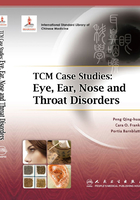
上QQ阅读APP看书,第一时间看更新
COMMENTARY AND DISCUSSION
The herpes simplex virus is the most common viral infections found in humans. It is easily transmited via the body fuids of the host. Primary infections occur early in life and then may remain dormant for many years, only to be reactivated later by fever, trauma, stress, immunosuppressive agents or exposure to ultraviolet radiation.
At present, Western medical treatment of HSK primarily consists of topical and internal anti-viral drug therapy to suppress recurrences. In contrast, the TCM treatment of clustered star nebula holistically integrates the use of antiviral medicinals with immune boosting ones, thus helping to shorten the course of the disease and prevent its recurrence. That said, because of the serious nature of HSK, a treatment strategy that integrates TCM with Western Medicine is ofen recommended.
The primary case in this chapter features a case of chronic, recurrent herpes simplex keratitis. Based on the narrative, we come to understand that, while the treatment controlled the acute symptoms, it has not prevented relapses. The virus was latent, becoming reactivated when she would catch a cold. Finally, the acyclovir eye drops were inefective and her condition worsened. She then pursues TCM treatment. This kind of clinical scenario is very commonly encountered in West, where patients exhaust the resources of Western medicine before turning to Chinese Medicine for help.
The pattern differentiation underscores an understanding of a complex pathogenesis: integrating knowledge of eye anatomy, external pathogen invasion and the complications that arise from these disharmonies. The treatment for her presentation of clustered star nebula is modifed Yín Qiào Săn combined with topical antiviral medication.
The key to the success in this first stage of treatment like, not only correct pattern identification and formula selection, but in the elegant modifications made to the formula. Because of the turbid hyperemia of the conjunctiva, chì sháo and zĭ căo are included to cool the blood and remove the redness. Zĭ căo is usually thought of as a medicinal for venting rashes and clearing damp heat from the skin. The cornea is on the surface of the eye, which also makes it a skin of sorts, and in this context, zĭ căo is a useful agent. Mù zéi căo and chán tuì are frequently used in ophthalmology to dispel wind, clear heat and remove nebula.
Three weeks later, she is significantly improved. The treatment now shifts to address her remaining symptoms. Carefully deconstructing the case presentation yields rich information, which can improve the inquiry skills of practitioner’s treating eye diseases.
At her reevaluation the treatment principles are updated to boost qi, nourish yin, clear heat and improve vision. Why boost the qi? Although she has not reported fatigue or poor appetite, the diagnosis is made because her eyes are tired. The local fatigue determines the diagnosis. Zī Yīn Tuì Yì Tāng is the selected formula. This formula is also featured in the chapter on ulcerative keratitis, underscoring its importance for treating and healing nebula. Within the formula, the only three qi tonics are included: huái shān yào, huáng jīng and zhì gān căo, all of which are neutral, harmonious and moistening in nature. The overall formula is nicely balanced with medicinals that support her constitution and the ongoing issue of healing her eye. In this way, both the root cause and branch symptoms are treated simultaneously.